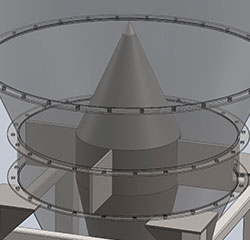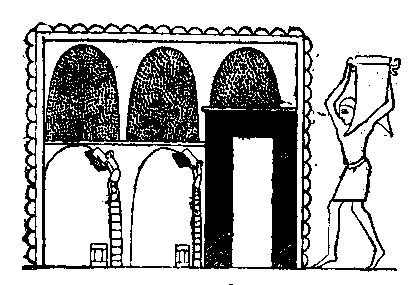
 It is not hard to imagine that early in our evolution the first people to store powder or ground material in a container very quickly found themselves hitting the container to get the stuff out. This was usually caused by the formation of either a stable arch or rathole. Arching occurs when an obstruction forms above the outlet and prevents any further material discharge. [modal destination=”/your-need/poor-flow/hopper-flow-obstruction-ratholing/” link_text=”Ratholing” caption=” ” caption=”A costly no-flow problem”] can occur when a solid has sufficient strength to cease flowing into a channel and a stable pipe results . Erratic flow can be the result of alternating arching and ratholing. Tired of hammering on equipment, engineers thus began the development of flow aids for bulk solids.
It is not hard to imagine that early in our evolution the first people to store powder or ground material in a container very quickly found themselves hitting the container to get the stuff out. This was usually caused by the formation of either a stable arch or rathole. Arching occurs when an obstruction forms above the outlet and prevents any further material discharge. [modal destination=”/your-need/poor-flow/hopper-flow-obstruction-ratholing/” link_text=”Ratholing” caption=” ” caption=”A costly no-flow problem”] can occur when a solid has sufficient strength to cease flowing into a channel and a stable pipe results . Erratic flow can be the result of alternating arching and ratholing. Tired of hammering on equipment, engineers thus began the development of flow aids for bulk solids.

Flow aids are used to return to a more regulated flow pattern and are relatively inexpensive. They are most often used in storage bins and chutes to promote flow of stored material, but they can also be used in continuous flow process vessels and conveyors. In my upcoming blogs I will be discussing the following 3 major types of flow aids in detail:
- Mechanical
- Vibrators
- Vibrating dischargers
- Agitators
- Pneumatic
- Air cannons
- Air pads
- Assisted air dischargers
- Chemical
- Fumed silica
- Magnesium stearate
The task of choosing a flow aid for a particular problem and knowing whether or not the device will work is more often accomplished by relying on experience or through trial-and-error, rather than the application of science and engineering. However, with knowledge of how solids flow through storage bins and other equipment, and an understanding of the properties of bulk materials that give rise to flow problems, selection and use of flow aids can be accomplished with a much higher level of confidence.
In my next blog, I will be discussing the features of mechanical flow aids in detail, so watch for our announcements! And remember to subscribe to our blog if you haven’t already.



